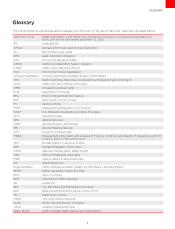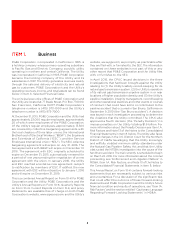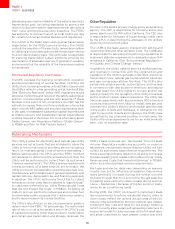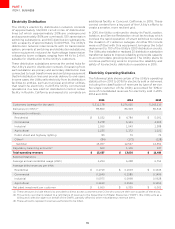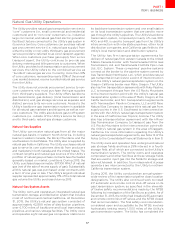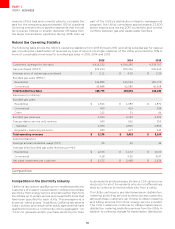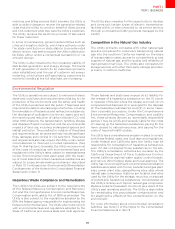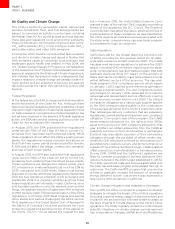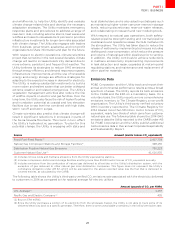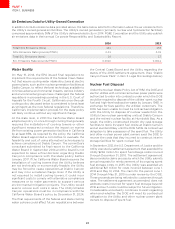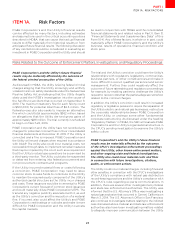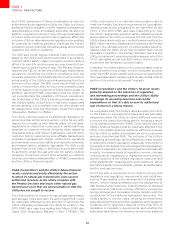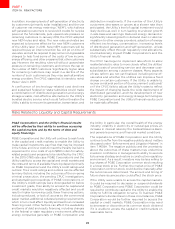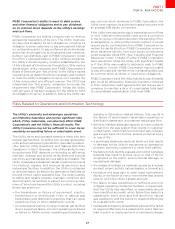PG&E 2015 Annual Report Download - page 25
Download and view the complete annual report
Please find page 25 of the 2015 PG&E annual report below. You can navigate through the pages in the report by either clicking on the pages listed below, or by using the keyword search tool below to find specific information within the annual report.
17
PART I
ITEM1.BUSINESS
Natural Gas Utility Operations
The Utility provides natural gas transportation services to
“core” customers (i.e., small commercial and residential
customers) and to “non-core” customers (i.e., industrial,
large commercial, and natural gas-fired electric generation
facilities) that are connected to the Utility’s gas system in
its service territory. Core customers can purchase natural
gas procurement service (i.e., natural gas supply) from
either the Utility or non-utility third-party gas procurement
service providers (referred to as core transport agents).
When core customers purchase gas supply from a core
transport agent, the Utility continues to provide gas
delivery, metering and billing services to customers. When
the Utility provides both transportation and procurement
services, the Utility refers to the combined service as
“bundled” natural gas service. Currently, more than 91%
of core customers, representing nearly 80% of the annual
core market demand, receive bundled natural gas service
from the Utility.
The Utility does not provide procurement service to non-
core customers, who must purchase their gas supplies
from third-party suppliers. The Utility oers backbone
gas transmission, gas delivery (local transmission and
distribution), and gas storage services as separate and
distinct services to its non-core customers. Access to the
Utility’s backbone gas transmission system is available
for all natural gas marketers and shippers, as well as non-
core customers. The Utility also delivers gas to o-system
customers (i.e., outside of the Utility’s service territory)
and to third-party natural gas storage customers.
Natural Gas Supplies
The Utility can receive natural gas from all the major
natural gas basins in western North America, including
basins in western Canada, the Rocky Mountains, and the
southwestern United States. The Utility also is supplied by
natural gas fields in California. The Utility purchases natural
gas to serve its core customers directly from producers
and marketers in both Canada and the United States. The
contract lengths and natural gas sources of the Utility’s
portfolio of natural gas purchase contracts have fluctuated
generally based on market conditions. During 2015, the
Utility purchased approximately 307,100 MMcf of natural
gas (net of the sale of excess supply of gas). Substantially
all this natural gas was purchased under contracts with
a term of one year or less. The Utility’s largest individual
supplier represented approximately 17% of the total natural
gas volume the Utility purchased during 2015.
Natural Gas System Assets
The Utility owns and operates an integrated natural gas
transmission, storage, and distribution system that includes
most of northern and central California. At December
31, 2015, the Utility’s natural gas system consisted of
approximately 42,800 miles of distribution pipelines,
over 6,700 miles of backbone and local transmission
pipelines, and various storage facilities. The Utility owns
and operates eight natural gas compressor stations on
its backbone transmission system and one small station
on its local transmission system that are used to move
gas through the Utility’s pipelines. The Utility’s backbone
transmission system, composed primarily of Lines 300,
400, and 401, is used to transport gas from the Utility’s
interconnection with interstate pipelines, other local
distribution companies, and California gas fields to the
Utility’s local transmission and distribution systems.
The Utility has firm transportation agreements for
delivery of natural gas from western Canada to the United
States-Canada border with TransCanada NOVA Gas
Transmission, Ltd. and TransCanada Foothills Pipe Lines
Ltd., B.C. System. These companies’ pipeline systems
connect at the border to the pipeline system owned by
Gas Transmission Northwest, LLC, which provides natural
gas transportation services to a point of interconnection
with the Utility’s natural gas transportation system on the
Oregon-California border near Malin, Oregon. The Utility
also has firm transportation agreements with Ruby Pipeline,
LLC to transport this gas from the U.S Rocky Mountains
to the interconnection point with the Utility’s natural gas
transportation system in the area of Malin, Oregon, at the
California border, and firm transportation agreements
with Transwestern Pipeline Company, LLC and El Paso
Natural Gas Company to transport this natural gas from
supply points in the U.S. Southwest to interconnection
points with the Utility’s natural gas transportation system
in the area of California near Topock, Arizona. The Utility
also has a transportation agreement with Kern River
Gas Transmission Company to transport gas from the
U.S. Rocky Mountains to the interconnection point with
the Utility’s natural gas system in the area of Daggett,
California. For more information regarding the Utility’s
natural gas transportation agreements, see Note 13 of the
Notes to the Consolidated Financial Statements in Item 8.
The Utility owns and operates three underground natural
gas storage fields and has a 25% interest in a fourth
storage field, all of which are connected to the Utility’s
transmission system. The Utility owns and operates
compressors and other facilities at these storage fields
that are used to inject gas into the fields for storage and
later withdrawal. In addition, four independent storage
operators are interconnected to the Utility’s northern
California transmission system.
During 2015, the Utility conducted an annual system-
wide review of its transmission pipeline class location
designations. The Utility also continued work to install
217 automatic and remote control shut-o valves on its
gas transmission system, as specified in the eleventh
of twelve safety recommendations made by the NTSB
following its investigation of the San Bruno accident. As of
December 31, 2015, the Utility had installed 235 automatic
and remote control shut-o valves, and the NTSB closed
that recommendation. The final safety recommendation,
considered open and acceptable by the NTSB, involves
hydrostatic testing nearly 1,000 miles of the Utility’s
gas transmission system. The Utility has completed the


